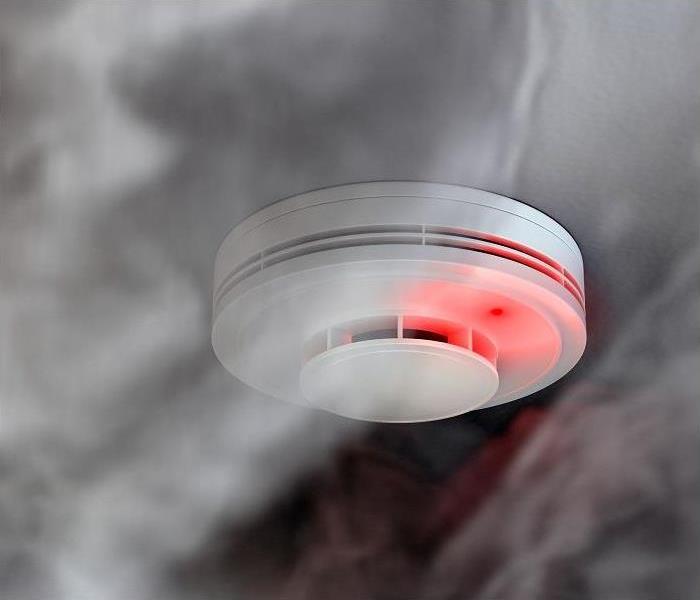How Challenging is Odor Removal After a Gaithersburg Structure Fire?
9/9/2020 (Permalink)
While There are Many Steps to Fire Restoration and Recovery, Lingering Noxious Odors can Hinder Comfortable Living in a House After a Disaster
Fires can present multiple layers of hazardous and damaging effects for Gaithersburg properties, many of which require the experience of professional fire restoration teams like SERVPRO to resolve. As widespread and threatening as these situations are, focused efforts like containment and cleaning can prevent these circumstances from overwhelming the house and its occupants. Odors are frequently one of the most challenging obstacles in this regard, as these conditions can spread far beyond the initially damaged ignition point.
Of all the fire damage in Gaithersburg homes after a disaster, our initial focus is rarely deodorization. In truth, these efforts most often happen at the end of the restoration process, where the final touches get made to the property before returning it to the homeowner. Despite the lack of urgency with removing odors, unlike other restoration practice is necessary after a fire, there are several steps that we can take throughout the recovery of your home to minimize the severity of odor damage and migrating smoke effects.
What Practices Can Reduce Odors?
We can understand the importance of making living conditions more comfortable for occupants when relocation is not required after a fire loss incident. As challenging and unlikely as this might initially seem to homeowners, we have effective containment practices that can reduce the spread and severity of odors, soot, and other hazards present in the house after the disaster. Understanding how each of these initial steps can impact the overall presence of noxious odors in the house is essential to ensure that these stages occur at the appropriate times. Some of the scent reducing practices we set in motion during fire restoration include:
- Debris Removal – Ash and partially combusted debris make up a considerable volume of the cleanup required immediately following extinguishment. In the ignition areas, these structural remnants are often wet, odorous, and responsible for circulating soot and smoke particles. Shoveling out this debris and cleaning up the spaces with wet vacuums can noticeably reduce odor concentrations.
- Surface Cleaning – Smoke residues can come to rest on services and contents, which can also be responsible for more severe odors in these specific areas. Through practices like wet cleanings, such as dissolving and emulsifying, we can trap and remove soils.
- Controlled Demolition – Demolition is always one of the last considered options for reducing the severity of odors and other circulating threats. By removing damaged portions of wall systems, flooring, and ceiling materials, we can better prepare the area for the reconstruction required and reduce odors at the same time.
What Deodorizing Products Help Absorb Foul Odors?
Apart from specific tasks that our SERVPRO team can perform to reduce odors present in the house after a fire in Gaithersburg, potent products can also help in this regard. Even before official deodorization begins, many products and counteractants can remove severe odors from the environment. These granules or solutions often get applied to areas with the most airflow to keep the spread of these fire damage smells to a minimum. Some of these products include:
- Counteracting Beads
- Deodorant Granules
- Water-Based Odor Counteractants
Are Special Tools Used in Odor Removal?
Deodorization is a necessary process that often falls at the end of the restoration phases for fire damaged homes and businesses in our region. There are multiple tools and technologies used in this endeavor, tailored specifically to the individual loss incident and these properties' needs. As in all aspects of restoration, our professionals find the most efficient path to make these fire losses "Like it never even happened." Some of the equipment used in this approach include:
- Thermal Foggers – Fogging is one of the most efficient methods for removing and neutralizing present odors in the house after a fire. Its gaseous state ensures that we can affect the overall environment where fire losses occurred and any porous materials surrounding this damaged point that might have absorbed smoke and its odors.
- Hydroxyl Machines – Hydroxyl machines are another popular choice for deodorization and environmental cleaning. These machines work in numerous ways to improve conditions within the house after a disaster. Onboard HEPA filtration removes harmful particulates from the air while UV cleaning approaches eliminate harsh odor molecules.
- Ozone Generators – The generation of ozone through these machines creates an unbalanced compound the bonds with odor molecules to neutralize them. As useful as these approaches can be, it is unsafe for living creatures to be around the same environment where ozone is present, slowing other restoration aspects when ozone is required.
Fire losses often leave harsh odors behind, but our SERVPRO of Gaithersburg / Germantown team can help. Contact us today at (301) 963-8474.






 24/7 Emergency Service
24/7 Emergency Service